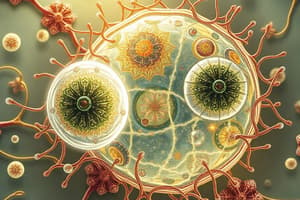Podcast
Questions and Answers
Who used a compound microscope to look at cork cells in 1665?
Who used a compound microscope to look at cork cells in 1665?
Robert Hooke
What did Matthias Schleiden determine in 1836?
What did Matthias Schleiden determine in 1836?
All plants are made of cells
Who suggested that all cells come from preexisting cells in 1855?
Who suggested that all cells come from preexisting cells in 1855?
Rudolf Virchow
All living things are composed of cells.
All living things are composed of cells.
Which type of cell is characterized by the absence of a nucleus?
Which type of cell is characterized by the absence of a nucleus?
Which of the following is NOT a characteristic of prokaryotic cells?
Which of the following is NOT a characteristic of prokaryotic cells?
Cells are the basic unit of ______ and function in living things.
Cells are the basic unit of ______ and function in living things.
Match the following cell characteristics with the correct cell type:
Match the following cell characteristics with the correct cell type:
Flashcards are hidden until you start studying
Study Notes
The Wacky History of Cell Theory
- Robert Hooke observed cork cells in 1665, calling them "tiny rooms"
- Anton van Leeuwenhoek discovered living cells, which he called "animalcules," in 1674
- Matthias Schleiden concluded that all plants are made of cells in 1836
- Theodor Schwann extended this to animals, stating that all animals are composed of cells in 1839
- Rudolf Virchow observed cell division, suggesting that all cells come from pre-existing cells in 1855
Cell Theory
- All living things are composed of cells
- Cells are the basic unit of structure and function in living things
- New cells are produced from existing cells
Prokaryotic Cells
- "Pro" refers to before
- "Kary" refers to nucleus (DNA)
- Found in bacteria
- Single-celled organisms
- Smaller than eukaryotic cells
- Lack a nucleus and membrane-bound organelles
- Only have a cell membrane
Eukaryotic Cells
- "Eu" refers to true
- "Kary" refers to nucleus (DNA)
- Found in all organisms except bacteria (protists, fungi, plants, animals)
- Can be single-celled or multicellular
- 10-100 times larger than bacteria
- Have a nucleus with DNA enclosed within a nuclear membrane
- Possess various membrane-bound organelles
Prokaryotes vs. Eukaryotes
- Prokaryotes
- Lack a nucleus
- Lack membrane-bound organelles
- Include bacteria
- Smaller in size
- Unicellular
- Simpler in structure
- Eukaryotes
- Have a nucleus
- Possess membrane-bound organelles
- Include all organisms except bacteria
- 10-100 times larger than prokaryotes
- Can be unicellular or multicellular
- More complex in structure
Studying That Suits You
Use AI to generate personalized quizzes and flashcards to suit your learning preferences.




